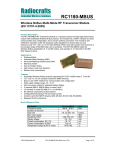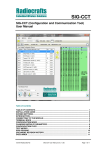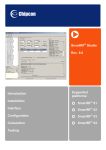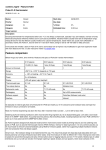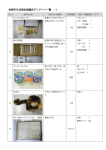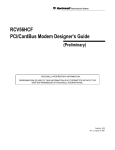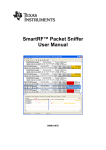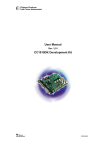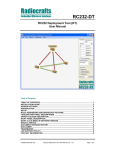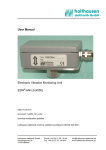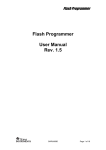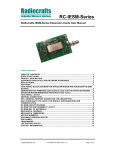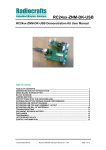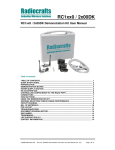Download - Radiocrafts AS
Transcript
Radiocrafts Embedded Wireless Solutions RC2300DK/RC2301DK RC2300DK/RC2301DK Demonstration Kit User Manual Table of contents TABLE OF CONTENTS ..........................................................................................................1 INTRODUCTION .....................................................................................................................2 DEMONSTRATION BOARD ...................................................................................................3 POWER SUPPLY SECTION ...................................................................................................4 RS-232 INTERFACE ...............................................................................................................5 CONNECTORS .......................................................................................................................6 PUSH BUTTONS.....................................................................................................................6 LEDS .......................................................................................................................................6 ACCELEROMETER ................................................................................................................6 POTENTIOMETER ..................................................................................................................7 LIGHT SENSOR ......................................................................................................................7 DEBUG AND PROGRAMMING INTERFACE .........................................................................8 I/O MAPPING ........................................................................................................................10 USING THE DEMONSTRATION KIT ....................................................................................11 SW IMPLEMENTATION ........................................................................................................11 CIRCUIT DIAGRAM ..............................................................................................................12 BILL OF MATERIALS ...........................................................................................................13 PCB LAYOUT........................................................................................................................14 TROUBLESHOOTING...........................................................................................................16 DOCUMENT REVISION HISTORY .......................................................................................17 DISCLAIMER.........................................................................................................................17 TRADEMARKS .....................................................................................................................17 LIFE SUPPORT POLICY.......................................................................................................17 CONTACT INFORMATION ...................................................................................................17 ©2007 Radiocrafts AS RC2300DK/RC2301DK Demonstration Kit User Manual (rev. 2.0) Page 1 of 17 Radiocrafts Embedded Wireless Solutions RC2300DK/RC2301DK Introduction The RC2300/RC2301 Zigbee-ready modules provide a very compact solution for a wide range of wireless network applications. The kit can be used to develop and test proprietary protocol applications as well as ZigBee-based applications. The RC2300 kit is normally shipped with an embedded firmware for range testing, while the RC2301 kit is shipped with a location demo firmware. The kit can be used for development of a customer’s proprietary protocol, or any Zigbee network implementation ported to the RC230x hardware platform. In this case the user would re-flash the modules with his own application, and the program/debug interface could be used for debugging also. The RC2300DK Demonstration Kit is designed to make it easy for the user to evaluate the module and/or develop an application very quickly. With the RC2300DK Demonstration Kit you can: • evaluate the RF performance of the modules • develop your own application interfacing the modules • build a prototype of your application This User Manual describes how to interface the Demonstration Kit and provide detailed documentation for the Demonstration Board and its onboard resources. Your RC2300DK Demonstration Kit should contain the following items: Kit contents RC2300DK Item Demonstration Board (RC2300DB) RS232 serial cable (1:1) AC/DC battery eliminator 6VDC Number of articles 2 2 2 Kit contents RC2301DK Item Demonstration Board (RC2301DB) RS232 serial cable (1:1) AC/DC battery eliminator 6VDC Quarter wave whip antenna Snap on battery clip (for blind node) Number of articles 8 1 7 8 1 ©2007 Radiocrafts AS RC2300DK/RC2301DK Demonstration Kit User Manual (rev. 2.0) Page 2 of 17 Radiocrafts Embedded Wireless Solutions RC2300DK/RC2301DK Demonstration Board The Demonstration Kit includes two Demonstration Boards. The Demonstration Boards contain the RC230x module and associated support circuits. The board provides an a serial port driver circuit for RS232 and the 9-pin D-Sub connector, DEBUG interface for programming and debugging, access to all digital and analogue I/O, push-buttons, LEDs, a potentiometer, a light sensor and an accelerometer as well as a voltage regulator. Configuration jumpers and connectors make it easy to interface the RC230x with various test equipment or the host used in an application. Not all components are needed in an actual application. Please see the datasheet for a typical application circuit. DC jack Digital I/O connector Supply voltage terminal block RESET LEDs RS232 D-Sub RC2300AT Antenna IO jumpers Accelerometer DEBUG VCC jumper Push buttons Light sensor Potentiometer Figure 1: RC230xDB Demonstration Board The SMA connector layout pattern is not used on this board (and is not connected to the module antenna output) as the module contains a chip antenna. Typical range measured between two boards in line-of-sight is 110 meters when the chip antennas are oriented vertically (or parallel). Indoors a range of 10-30 can be expected, depending on the materials in walls and floors. ©2007 Radiocrafts AS RC2300DK/RC2301DK Demonstration Kit User Manual (rev. 2.0) Page 3 of 17 Radiocrafts Embedded Wireless Solutions RC2300DK/RC2301DK Power supply section The board contains a voltage regulator. You can choose between applying a 4-10V unregulated supply voltage at the DC jack (like the battery eliminator included in the kit), or the screw terminal where a battery pack or some other supply can be connected. The onboard regulator drops the voltage to 3.0V. A green LED will light up the board is connected to a power source. Input supply voltage range is 4 – 10 V. A series diode protects the circuit against wrong polarity. The current supply to the module is through the jumper at P13, pin 3 and 4. An ampere meter can be connected here in order to measure the DC current drawn by the module. Remove the jumper and replace by an ampere meter in order to measure the current. The location of P13, pin 3 and 4, are shown in the figure below. P13, pin 3 and 4. Connect a jumper or an ampere meter here Figure 2. Module current consumption measurement Note: To ensure proper Power-On Reset (POR) the wall socket end of the AC/DC battery eliminator should be inserted first, and then the DC-jack into the board. If the VCC power-on rise-time specification is not met, the board may need the RESET to be activated to ensure correct start-up. ©2007 Radiocrafts AS RC2300DK/RC2301DK Demonstration Kit User Manual (rev. 2.0) Page 4 of 17 Radiocrafts Embedded Wireless Solutions RC2300DK/RC2301DK RS-232 interface The Demonstration Board provides an RS232 driver circuit. The serial port is configured as a data modem and a 1:1 cable should be used to connect the board to the PC. The RTS/CTS handshaking pair is also provided, so that hardware handshaking may be used on this port. The serial port (RXD and TXD) and handshaking signals can be HW enabled by doing the following hardware changes: • • Insert jumpers at P13 to connect RXD and TXD to the RS232 driver Insert jumpers at P13 to connect CTS and RTS to the RS232 driver if hardware handshake is to be used P13 is used to set jumpers to connect the module UART interface to the RS232 PHY driver. Normally the jumpers connecting RXD and TXD are installed, and provide UART communication with a PC without handshaking. With the jumpers removed the modules RXD and TXD can easily be connected to a host using logic levels, for instance a microcontroller or external development board. The table below shows the pinout and signals at P13. There are two LEDs indicating traffic activity on the UART. A green LED is connected to the RXD line, and a red LED at the TXD line. Pin no. Signal 1 3 2 4 GND VCC 5 7 9 11 13 6 8 10 12 14 RXD TXD CTS RTS GND Note Ground Jumper installed from factory. Can be used for current measurement Jumper installed from factory Jumper installed from factory Install jumper when using hardware handshake Install jumper when using hardware handshake Ground Connect jumpers here for TXD and RXD Connect jumpers here for hardware handshake (CTS, RTS) Figure 3. RS232 driver interface (Photo to be updated!) ©2007 Radiocrafts AS RC2300DK/RC2301DK Demonstration Kit User Manual (rev. 2.0) Page 5 of 17 Radiocrafts Embedded Wireless Solutions RC2300DK/RC2301DK Connectors The Demonstration Board is furnished with many connectors for easy access to all module signals. P5 bring out supply voltage, the DEBUG interface, a spare digital data I/O signal (Port 2) and the RESET line. P6 brings out digital and analogue I/O (Port 0). A 2.54 mm pitch pin-row can be mounted at P6 if convenient. P7 brings out digital I/O (Port 1) and the 32 kHz oscillator clock pins. A 2.54 mm pitch pin-row can be mounted at P7 if convenient. P8 is the DEBUG interface (pin compatible with the TI / Chipcon SmartRF04DB DEBUG connector). P9 is a connector for jumpers to connect/disconnect the on-board analogue sensors preventing them loading the pins when not used. P10 is a connector for jumper to connect VCC from the demonstration board back to the programmer/EB. For detailed signal description, please refer to the pinout shown in the data sheet. Push buttons The Demonstration Board is furnished with 6 push buttons connected to the following I/O signals: Demo Board marking S1 S2 S3 S4 S5 S7 RC2300 module pin P0.1 P0.6 P1.2 P1.3 P2.0 RESET. Pressing this button will activate the main RESET of the module LEDs The Demonstration Board is furnished with one green power indicator LED, two LEDs indicating UART activity as described above, and 2 LEDs connected to general I/O signals: Demo Board marking D3 D6 LED color and RC2300 module pin Green: P1.0 Red: P1.1 Accelerometer The accelerometer can be used measure movements in 2-axis, it can also be used for tilt measurement by measuring the earths gravitation. Accelerometer self test can be initiated by shorting test point T1 to ground. The accelerometer has a 20 ms start-up time after power on. See the Analog Devices ADXL321 datasheet for details about the accelerometer. ©2007 Radiocrafts AS RC2300DK/RC2301DK Demonstration Kit User Manual (rev. 2.0) Page 6 of 17 Radiocrafts Embedded Wireless Solutions RC2300DK/RC2301DK Potentiometer The potentiometer is connected as a voltage divider between supply voltage and ground. Turning the knob clock-wise gives maximum voltage. Light sensor A light dependent resistor (LDR) measures the light level and gives an analogue signal that can be measured by the RC230x A/D converter. The light sensor resistance ranges from 5K (light) to 20M (dark), and is connected a voltage divider together with a 200k Ohm resistor to the supply voltage. See the Silonex NSL-19M51 datasheet for details about the LDR. ©2007 Radiocrafts AS RC2300DK/RC2301DK Demonstration Kit User Manual (rev. 2.0) Page 7 of 17 Radiocrafts Embedded Wireless Solutions RC2300DK/RC2301DK Debug and programming interface The Demonstration Board provides a DEBUG interface used to program firmware into the onboard module and for debugging the code. The DEBUG interface is compatible with the DEBUG interface at the Texas Instruments / Chipcon SmartRF04EB board. This board and its associated software are available from TI / Chipcon. The table below shows the P8 SOC debug connector pin-out. See figure Figure 4. Another option for programming is a third party programmer as FlashPro-CC from Elprotronic, as shown in Figure 5 Debug interface pin 1 2 3 4 5 6 7 8 9 10 Function GND VCC (Insert jumper at P10 to connect VCC from target to the programmer/EB) Debug Clock (DC) Debug Data (DD) CSn (optional) SCL (optional) RESET_N MOSI (optional) NC (not connected) MISO (optional) Below is shown how to connect the RC2300DB to the SmartRF04EB. ©2007 Radiocrafts AS RC2300DK/RC2301DK Demonstration Kit User Manual (rev. 2.0) Page 8 of 17 Radiocrafts Embedded Wireless Solutions RC2300DK/RC2301DK Figure 4. Programming interface connection from SmartRF04EB (Texas Instruments) Figure 5. Programming interface connection from FlashPro-CC ©2007 Radiocrafts AS RC2300DK/RC2301DK Demonstration Kit User Manual (rev. 2.0) Page 9 of 17 Radiocrafts Embedded Wireless Solutions RC2300DK/RC2301DK I/O mapping The following table is a summary of the I/O mapping and their connection to the on-board resources. In the same table the pin usage for the TI/Chipcon CC2430DB is shown for reference. I/O port P0.0 RC2300 pin 8 P0.1 P0.2 P0.3 P0.4 9 10 11 12 P0.5 13 P0.6 P0.7 14 15 P1.0 P1.1 P1.2 29 28 27 RC230xDB Demo Board Light dependent resistor (through jumper) S1 push button I2C_SDA I2C_SDL Accelerometer x-axis (through jumper) Accelerometer y-axis (through jumper) S2 push button Potentiometer analogue input (through jumper) D3, Green LED D6, Red LED S3 push button P1.3 P1.4 P1.5 P1.6 P1.7 P2.0 26 25 24 23 22 5 S4 push button CTS RTS TXD RXD S5 push button P2.1 P2.2 RESET 4 3 6 Debug data Debug Clock S7 push button, RESET. Pressing this button will activate the main RESET of the module ©2007 Radiocrafts AS CC2430DB TI/Chipcon demo board Light dependent resistor Push button EEPROM SDA EEPROM SCL Accelerometer x-axis Accelerometer y-axis Joystick analogue signal Potentiometer analogue input Green LED Red LED Voltage control for I/O modules General purpose I/O CTS RTS TXD RXD Joystick push interrupt active high Debug data Debug Clock RESET RC2300DK/RC2301DK Demonstration Kit User Manual (rev. 2.0) Page 10 of 17 Radiocrafts Embedded Wireless Solutions RC2300DK/RC2301DK Using the Demonstration Kit The Demonstration Kit is useful for providing hands-on experience with the RC2300 for both software and hardware developers. The Data Sheet for the module provides detailed information on the internal resources and available I/Os of the modules. Important: The use of radio transceivers is regulated by international and national rules. Radiocrafts’ modules meet the regulations in EU and US/Canada for different frequency variants. Make sure the local regulative are according to these rules. Your local telecommunication authorities can provide more information on use of un-licensed radio transmitter in your country. SW implementation For implementing your application IAR Embedded Workbench is recommended. En example IAR project for the embedded microcontroller can be downloaded from TI/Chipcon homepage. User guides for how to integrate module programming into IAR is also available there. The Z-stack from TI/Chipcon currently (rev 1.4.2) supports only revision 7.20H of the IAR Embedded Workbench and not the newest (7.21 and 7.30). Check TI’s website http://focus.ti.com/docs/toolsw/folders/print/z-stack.html for latest update on this. A flyer for IAR Embedded Workbench is included in the kit. More info on IAR can be found on IAR homepage (www.iar.com). ©2007 Radiocrafts AS RC2300DK/RC2301DK Demonstration Kit User Manual (rev. 2.0) Page 11 of 17 Radiocrafts Embedded Wireless Solutions RC2300DK/RC2301DK Circuit Diagram The circuit diagram is shown below. A full resolution schematic is found in RC2300DB_1_0.zip (available from Radiocrafts’ website). ©2007 Radiocrafts AS RC2300DK/RC2301DK Demonstration Kit User Manual (rev. 2.0) Page 12 of 17 Radiocrafts Embedded Wireless Solutions RC2300DK/RC2301DK Bill of materials Reference C1 C2 C3-7;C10 C8-9 D1 D2-4 D6-7 M1 P1 P2 P3 Quantity 1 1 6 2 1 3 2 1 1 1 1 P4 P8 P9 P10 P13 1 1 1 1 1 SMA CON_2X5_TH_MALE CON_2X4_TH_MALE CON_2_TH_MALE CON_2X10_TH_MALE R1 R2 R7-9;R1112 R3-4,R10 R5; R13 RT1 S1-5, S7 U1 U2 U3 1 1 NSL-19M51 R_200K_0603_F Description Capacitor, 0603 Capacitor, tantal Capacitor, 0603 Capacitor, 0603 Diode, Si LED, green, SMD LED, red, SMD RF Module D-Sub, 9 pin, female 2 pin terminal, screw DC jack, 2.5mm center pin SMA connector, straight Not populated Connector 10 pins, pin header Connector 8 pins, pin header Connector 2 pins, pin header Connector 20 pins, pin header Light Sensitive Resistor, 5k20M Ohm Resistor, 0603 5 3 2 1 7 1 1 1 R_100K_0603_G R_150_0603_G R_1K0_0603_J 72PTR10K PUSH_BUTTON MAX3232 LP2980-3.0V ADXL321 Resistor, 0603 Resistor, 0603 Resistor, 0603 Trimming pot, 10K, knob Push button, SMD RS-232 Transceiver, SO-16 3.0V low drop-out regulator Dual-axis Accelerometer, QFN ©2007 Radiocrafts AS Part number C_2U2_0603_X5R_K_10 C_3U3_TAN_B C_100N_0603_X7R_K_50 C_10N_0603_X7R_K_50 BAT254 LED_CL150GCD LED_CL150URCD RC2300AT DSUB_9F SCREW_TERM_2 DC_JACK_2.5 RC2300DK/RC2301DK Demonstration Kit User Manual (rev. 2.0) Page 13 of 17 Radiocrafts Embedded Wireless Solutions RC2300DK/RC2301DK PCB layout The PCB is a simple 2-layer board where the bottom layer is used as ground plane. The laminate used is standard FR-4 board material. The PCB is 1.6mm thick. Full resolution layout and assembly drawing are found in RC2300DB_1_0.zip. Figure 6. RC2300DB PCB layout, top layer (1) Figure 7. RC2300DB PCB layout, bottom layer (2) ©2007 Radiocrafts AS RC2300DK/RC2301DK Demonstration Kit User Manual (rev. 2.0) Page 14 of 17 Radiocrafts Embedded Wireless Solutions RC2300DK/RC2301DK Figure 8. RC2300DB PCB component placement, top side ©2007 Radiocrafts AS RC2300DK/RC2301DK Demonstration Kit User Manual (rev. 2.0) Page 15 of 17 Radiocrafts Embedded Wireless Solutions RC2300DK/RC2301DK Troubleshooting It doesn’t work • First, measure the supply voltage at P13, pin 3. Should be 3.0V. • Make sure that a jumper is installed or an ampere meter is connected between pin 3 and 4 on P13. • Is the supply voltage correctly polarized? If not, the protection diode will prevent any current from flowing. + and – are indicated on the PCB, on the DC jack, the tip is + and the ring is –. • Is the battery eliminator plugged into the wall socket? • Was the wall socket plugged in first, then the DC-jack to ensure quick rise-time on VCC? If not the module may have to be reset after power on. Press the RESET button. • Is the wall outlet at the rated voltage printed on the AC/DC battery eliminator (220V or 110V)? • Is the module programmed with the proper firmware? If not use the TI / Chipcon SmartRF04EB DEBUG interface to load the firmware. I cannot communicate with the RC2300 UART through the serial port • Make sure that the RXD and TXD jumpers are inserted • Make sure that you are using a correctly wired 1:1 cable (as the one provided with the kit) • Make sure the PC (or host) is configured for the correct serial port • Make sure the PC serial port settings are correct with respect to baud rate, data bits, stop bits, parity bits and handshake ©2007 Radiocrafts AS RC2300DK/RC2301DK Demonstration Kit User Manual (rev. 2.0) Page 16 of 17 Radiocrafts Embedded Wireless Solutions Document Revision History Document Revision 1.0 2.0 RC2300DK/RC2301DK Changes New document Updated with RC2301DK, and information on programming options Disclaimer Radiocrafts AS believes the information contained herein is correct and accurate at the time of this printing. However, Radiocrafts AS reserves the right to make changes to this product without notice. Radiocrafts AS does not assume any responsibility for the use of the described product; neither does it convey any license under its patent rights, or the rights of others. The latest updates are available at the Radiocrafts website or by contacting Radiocrafts directly. As far as possible, major changes of product specifications and functionality, will be stated in product specific Errata Notes published at the Radiocrafts website. Customers are encouraged to check regularly for the most recent updates on products and support tools. Trademarks SPPIO is a trademark of Radiocrafts AS. ZigBee is a registered trademark of the ZigBee Alliance. All other trademarks, registered trademarks and product names are the sole property of their respective owners. Life Support Policy This Radiocrafts product is not designed for use in life support appliances, devices, or other systems where malfunction can reasonably be expected to result in significant personal injury to the user, or as a critical component in any life support device or system whose failure to perform can be reasonably expected to cause the failure of the life support device or system, or to affect its safety or effectiveness. Radiocrafts AS customers using or selling these products for use in such applications do so at their own risk and agree to fully indemnify Radiocrafts AS for any damages resulting from any improper use or sale. © 2007, Radiocrafts AS. All rights reserved. Contact Information Web site: www.radiocrafts.com Email: [email protected] Address: Radiocrafts AS Sandakerveien 64 NO-0484 OSLO NORWAY Tel: +47 4000 5195 Fax: +47 22 71 29 15 E-mail: [email protected] ©2007 Radiocrafts AS RC2300DK/RC2301DK Demonstration Kit User Manual (rev. 2.0) Page 17 of 17

















